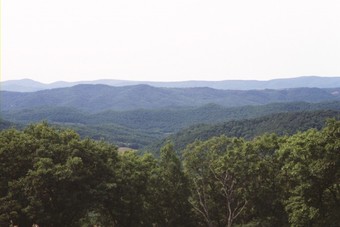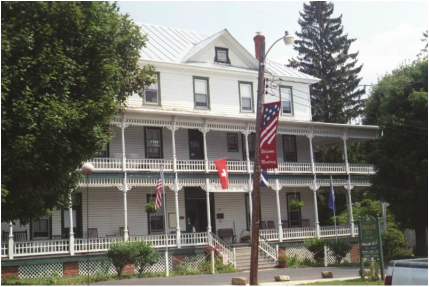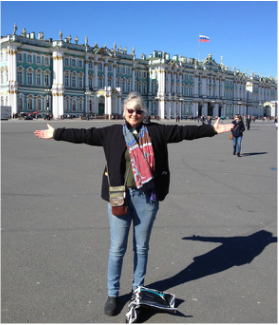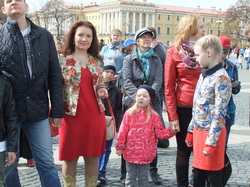 Virginia always takes me by surprise. I’ll be rearranging my NetFlix queue or doing some other essential but non-essential thing - cooking, dusting, or paying bills - and a green flash of Virginia darts in. The blue, hazy vistas. The open high mountain pastures. Fat yellow, black and white striped monarch butterfly caterpillars munching on milk weed. White two-story farmhouses with green roofs and wrap-around porches. The images elbow each other for room in my mind. I stop, pull back from whatever I'm doing, and let it all flow over me. I invite in those ancient folded Appalachian ridges that stretch from Newfoundland to Alabama and pull up little slices of Virginia luck. Pale pink spring cherry blossom petals blanketing the ground, up to my ankles. A sign in the window of the H&H Cash Store in Monterey, next to a poster for maple syrup and buckwheat flour: If we don’t have it, you don’t need it. The August heat hammering down any thought of moving quickly. Thousands of Arbogasts in the wide Shenandoah Valley and the steeps and flats of Highland County. Tiny Willie’s Pit BBQ hole-in-the-wall BBQ in Staunton that’s not there anymore.
 And then, a few days later on Tuesday, April 26 at 7 p.m., after I have checked in and found my long-lusted-after seat in a rocking chair on the second story porch at the Highland Inn in Monterey, high up in the "little Switzerland" of Virginia, I am lucky enough to do a reading at the public library. It was in Highland County that I began to understand that in the debris of Jim’s death was a remarkable gift, really a rare chance to remake myself --the core of Leave the Dogs at Home’s story: Here's an excerpt: White picket fences announced McDowell, which was really just a few houses along the road. It was easy to find the old house—it was the only brick house in town. It was a Hull family house built in the 1800s that had served as a Stonewall Jackson headquarters, a Civil War hospital, a hotel, a stagecoach stop, and now a museum. I left the girls in the Element under a lone tree several blocks away, every possible window open, water dish filled to the brim, and calculated I had an hour before the sun moved from behind the tree to beat down on them. A stray breeze moved through the thick air. Maybe it was slightly less hot here. My elderly cousin was waiting for me upstairs at a heavy wooden table in a room lined with genealogy books. The slight scent of mildew tickled my nose. An air conditioner cranked noisily in the window. My shorts and T-shirt seemed disrespectful next to his white pressed shirt and brown suit and tie. He listened to me recite my lineage, nodding his head at each generation. Elizabeth and Michael. Elisabeth and David. Katherine and Enos. Isabele and Sanford. Cordelia and Enos. Pearl and Straud. Maxine and Elmore. “Yes, I know your family,” he said. “And I know where the old house is.” I unfolded a map and scooted it across to him. He ran his thin, smooth fingers over the web of back roads. “The old house is here,” he said, tapping at the map with his index finger. “In the field behind a newer house. As you drive around this curve you can just see it. It’s before the road turns to gravel and goes up the mountain. It was in Arbogast hands until a few years ago, but they had to sell.” Three hours later I pulled the truck over onto a small grassy shoulder in the curve of road next to a flock of sheep, the dogs whining to chase the herd. I thought this spot might be where my cousin had pointed to on the map. There was an old house set back far away. I couldn’t really see. The air undulated in the broiling sun. And then it hit me. It didn’t matter if this was the house or not. What mattered was how Michael had broken free from the restraints and traditions of the old ways to find a new way in a new land. He had left the old wars and took on new ones. While others cried and whined over being duped by the Soul Traders, he served his time and made his dream happen. Who knows what misery and horror he might have seen, being the only survivor of his German family, who may have been wasted by typhoid fever or mowed down in war. But Michael built a better life on the disaster of their deaths. As surely as he mourned them, he lived proudly and made Arbogast a name that rings with honor across the Shenandoah Valley. My Jim and career disasters seemed so shallow in comparison and my bleak grief over the loss of the former me so indulgent. But one thing was for sure: my life was getting better. I wasn’t headed for just a different life, but a better one and a better me. One that would not be here if Jim were alive. And it was time to be grateful and unabashed about living it. This is verboten thinking. Widows and left-behind lovers are never supposed to say this. We’re supposed to say that our relationships and marriages were perfect. You were crazy in love. It’s like half of you is gone, He was everything to me. Once your main squeeze kicks the bucket, the union, no matter how complicated or imperfect, becomes sacrosanct. The dead one golden and wonderful, the one left behind without a reason to go on. All the bad times must fall away, and only the good times can remain. We are allowed to stumble onward, bravely. We are allowed to heal and learn to enjoy life again. We are allowed to love again. But we are not supposed admit that life is better after a lover’s death. I needed to write about this, but I didn’t want to. People would think it was cathartic, therapy writing, a cleansing. A way for me to process my emotions. But I was doing just fine processing. I didn’t even think I was forging new ground. All I was doing was walking a path walked by many but unspoken of, and these important things needed to be said out loud. It’s not that I was glad that Jim was dead, but he was. And because of the chaos of his death I had a chance to break out of my crystallized and hardened patterns of predictability, to crack the calcified static of my life. In the rubble of Jim’s illness and death, I had a chance to walk into the next stage of my life with a new perspective. Some people never have, or take, this chance; instead they become frozen into who they are, what they think, how they act.”
1 Comment
 I was shocked to discover, via a May 15 article in the NYT, that the stereotype for solo travelers is someone who is “single and looking,” on a dating holiday. Really? Of course, people would only go on vacation by themselves if they were looking for sex, or perhaps marriage! Not looking for the brilliant onion domes of the Church of the Savior on Spilled Blood, not yearning for a perfect croissant in street-side cafe, not hoping to wander for a day in acres of gardens. No, we’re out touring the world hoping to get lucky, to cure ourselves of the singleton disease. This is news to me and the all the other people that make up the one in five people who traveled on their own on their most recent leisure trip, mostly women. The Visa study cited noted that solo traveling was done mainly by “Women Wanderers” under age 45 (rats, I was hoping for a good showing for the over-60 crowd), and half were professionals from China and India. Again, down come crashing myths. What? Women from restrictive, third-world countries are professionals and they travel by themselves more than women from the USA? The most frequent response I have to my solo womanly world wanderings is, “Oh you are so brave to go by yourself.” I have a hard time knowing what to say back. By nature, I am not a joiner. I live by myself and have for most of my life. So what, I’m supposed to hunker down with a tour group or cozy up with someone for a couple weeks of tight quarters? I’ve tried it, and learned. I don’t want to spend my vacation negotiating with someone else about when we go where, why. I don’t find the constant chatter of a companion a good sound track for exploration. Interjecting worry about whether or not my pal having a good time, is an extra layer of stress I prefer to leave behind. So far, Steve and I are able to travel together peacefully, but his companionship is not a requirement for me to go on a trip. I just returned from a ten-day solo adventure to Russia. A place shrouded in media myths; a country with a remarkable history and role in today’s world churn, it provided a double whammy to folks’ amazement about me traveling alone. “Ew, why Russia? By yourself? You are so brave!” Oh Fiddlesticks! I‘m not brave; I’m a well-researched, curious traveler. I felt I needed to get to Russia if I was ever going to. Emotions are running high out there in the rarefied clouds of global politics, who knows when the doors would close and I would miss the chance to walk through palaces, past onion dome Orthodox churches, down blocks and blocks of beautiful buildings while thinking about Mongol Hordes, serfdom, the siege of Leningrad, the great social experiments of socialism and communism? Miss finding bowls of borscht or Uha fish soup, plates of pickled herring, or piles of Pelmeni dumplings stuffed with mushrooms? Miss immersing myself for days in art, losing myself in a night of flawless, extravagant, and passionate ballet? Miss wandering through sophisticated shops while cosmopolitan, stylish women stride tall beside me? No way! There were hard moments during the trip but I’m not sure any of them would have been better if someone else was there. In fact, I finally settled on a very Zen-like, do-one-thing concentration to get myself around in the enormous public spaces and the particularly vexing Moscow metro. I found time slipped away, paring down my vacation to-do list with the velocity of a sharp Soviet scythe. I’m glad I didn’t have to argue with anyone about where I was or what was getting chopped off the list. Here are a couple essays from my days there. May 2 St. Petersburg: Go with the flow |
Inside
|




 RSS Feed
RSS Feed